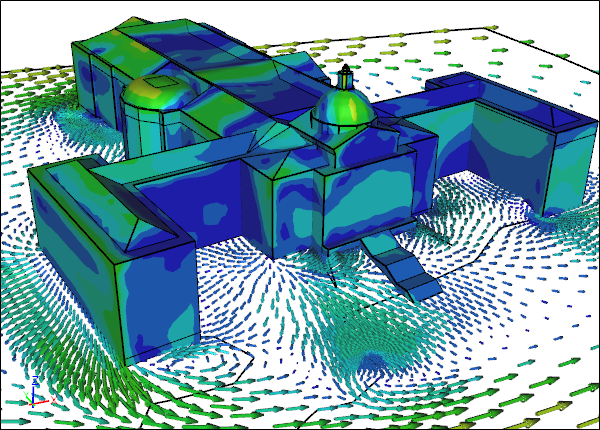
Reduced Complexity 3D Models for CFD
Reduced complexity 3D model for Computational Fluid Dynamics (CFD) is a great way to avoid getting bogged down in details that are not relevant for a simulation. 3D video games and 3D animation applications have been using reduced complexity 3D models combined with texture maps to present rich visuals since the dawn of the digital age. These models and the concepts to build them can be extremely useful for CFD.
 CFD Simulation of the Massachusetts State HouseStreamlines colored by velocity magnitude
CFD Simulation of the Massachusetts State HouseStreamlines colored by velocity magnitude
Game developers worked out a long time ago that you don't need fully detailed 3D models for them to look plausible to gamers. By using reduced polygon sets combined with the magic of texture mapping, developers were able to render the details gamers demanded, all in real time.
Texture mapping is also used within SketchUp (a 3D presentation and animation application) to layer more detail than is available through the underlying 3D model alone.
 Massachusetts State House Texture Mapped
Massachusetts State House Texture Mapped
Without the texture map the bare 3D model is still recognizable as the Massachusetts State House, but you can clearly see it is an approximation.
 Massachusetts State House Shaded
Massachusetts State House Shaded
This style of reduced complexity 3D model is ideal for CFD analysis if you are interested in general airflow patterns around the building, or if you plan to modify a feature such as the dome. If you want to analyze a specific area then you can always model that region in higher detail (including higher mesh density) while keeping the regions further away at a reduced detail and lower mesh density.
 CFD Simulation of the Massachusetts State HouseVelocity magnitude contours and arrows
CFD Simulation of the Massachusetts State HouseVelocity magnitude contours and arrows
If you were to design such a building, using relatively simple 3D models would be an ideal starting point. You could iterate through a number of shapes quickly and assess their aerodynamics before settling on a final design for more detailed analysis.
Notes
- The original Massachusetts State House model is from the SketchUp 3D Warehouse.
- The simulation was performed in Caedium Professional using the incompressible, steady-state RANS solver with the k-omega turbulence model.
Recent blog posts
- CFD Simulates Distant Past
- Background on the Caedium v6.0 Release
- Long-Necked Dinosaurs Succumb To CFD
- CFD Provides Insight Into Mystery Fossils
- Wind Turbine Design According to Insects
- Runners Discover Drafting
- Wind Tunnel and CFD Reveal Best Cycling Tuck
- Active Aerodynamics on the Lamborghini Huracán Performante
- Fluidic Logic
- Stonehenge Vortex Revealed as April Fools' Day Distortion Field
